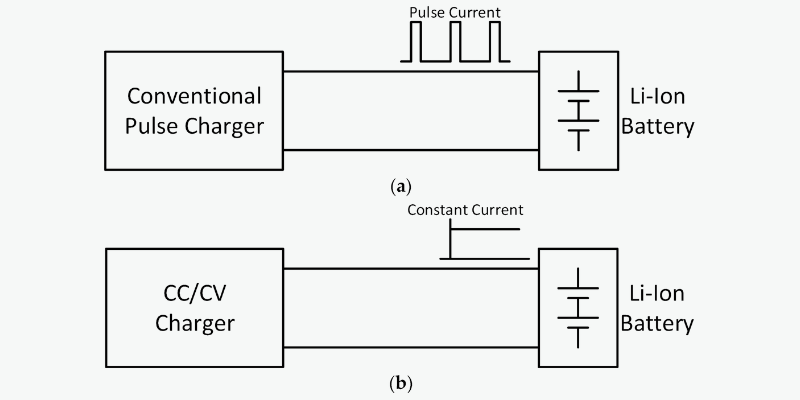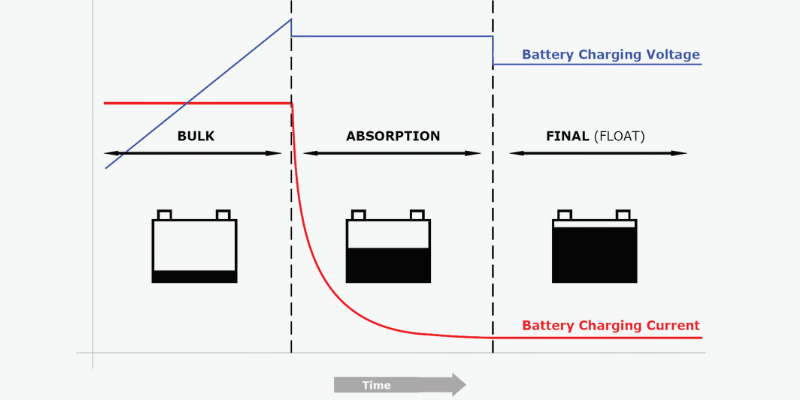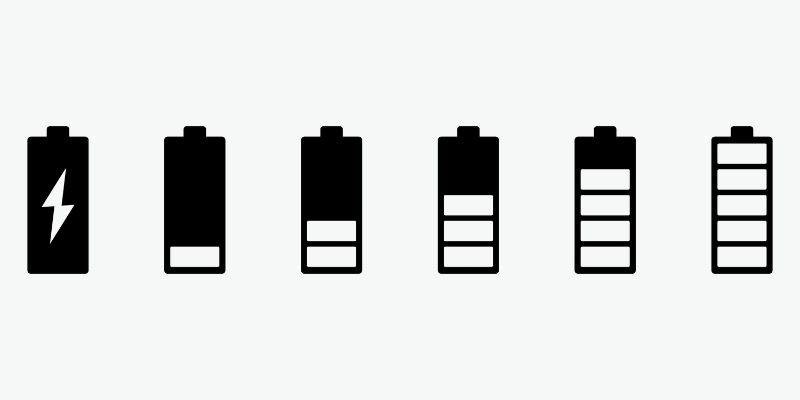Conclusión clave:
- Seleccione la técnica de carga adecuada para su batería para maximizar la eficiencia, minimizar el daño y extender su vida útil. Desde voltaje constante hasta carga aleatoria, cada método afecta la salud de la batería de manera diferente.
Los métodos de carga de la batería afectan el rendimiento y esperanza de vida. La corriente excesiva impide reacciones completas, aumentando la resistencia y la temperatura, dañando los materiales. La baja corriente prolonga el tiempo de carga, lo que supone un inconveniente para los usuarios. Elegir el método de carga correcto es crucial para maximizar el rendimiento sin una carga prolongada.
En esta guía, exploraremos 9 tipos comunes de carga de batería. – desde la carga de voltaje constante hasta la carga aleatoria.
Carga de voltaje constante
El método de carga de voltaje constante utiliza una fuente de voltaje fijo para cargar las baterías. Sus ventajas incluyen una estructura de circuito simple y un diseño de circuito de control sencillo.
En este modo, la corriente de carga disminuye a medida que la batería se acerca a la carga completa. Una vez completamente cargado, el cargador cambia automáticamente a carga flotante, manteniendo la carga completa de la batería.
Sin embargo, este método tiene un inconveniente. En las primeras etapas de carga, el bajo voltaje en los terminales de la batería da como resultado una corriente de carga inicial excesivamente alta. Esto puede dañar las placas de la batería, aumentar la temperatura de la batería y acortar su vida útil.
Para abordar este problema, se puede emplear un método de carga de voltaje de múltiples etapas. Este enfoque utiliza inicialmente un voltaje de carga más bajo y luego lo aumenta a medida que aumenta el voltaje del terminal de la batería.
Carga de corriente constante
El método de carga de corriente constante carga la batería con una corriente constante.
Al igual que el método de voltaje constante, cuando la batería está completamente cargada, el cargador debe cambiar al modo de carga flotante para evitar daños por sobrecarga.
En comparación con la carga de voltaje constante, este método puede cargar completamente la batería rápidamente.
Sin embargo, debe monitorear la cargando la batería nivel de cerca. Dado que el cargador proporciona continuamente una corriente constante, si no se detiene la carga o se cambia al modo lento cuando la batería está llena, se producirá una sobrecarga. Esto puede dañar las placas de la batería y reducir su vida útil.

Carga de corriente cónica
La carga de corriente cónica es un proceso en el que la corriente de carga disminuye gradualmente a medida que aumenta el voltaje de la celda, o la fuerza electromotriz inversa (fem inversa). Este método utiliza una fuente de energía no regulada, donde el voltaje y la corriente no están controlados con precisión.
A medida que la batería se carga, su resistencia interna disminuye, lo que permite que fluya más corriente hasta que la batería alcanza la carga completa.
Sin embargo, la facturación no regulada plantea riesgos, incluida la sobrecarga. Esto puede provocar calor excesivo, formación de gases y daños a la batería, lo que reduce la vida útil y crea riesgos para la seguridad si no se maneja con cuidado.
La carga de corriente cónica es adecuada únicamente para baterías SLA.
Carga pulsada
La carga por impulsos utiliza corriente de impulso periódica para cargar las baterías. Las pausas en la carga permiten que el electrolito se difunda de manera más uniforme, mejorando la eficiencia. Esto permite que la energía de carga se convierta completamente en energía eléctrica, lo que resulta en una mayor eficiencia de carga.

Carga de eructos
La carga refleja o de pulso negativo, también llamada "carga de eructo", es un método que aplica un pulso de descarga muy corto durante un período de descanso de carga para despolarizar la célula.
Este pulso, normalmente de 2 a 3 veces la corriente de carga durante 5 ms, tiene como objetivo desalojar las burbujas de gas acumuladas en los electrodos durante la carga rápida.
Este proceso, conocido como "eructar", acelera la estabilización y el proceso de carga general. Sus defensores afirman que esta técnica mejora las tasas de carga, la vida útil de la batería y elimina las dendritas. Sin embargo, estas afirmaciones siguen siendo controvertidas.
Carga IIU
Este es un perfil de carga rápida para baterías de plomo-ácido inundadas específicas, no apto para todas las baterías de plomo-ácido.
Tiene tres fases:
1. Carga de corriente constante (I) hasta que el voltaje alcance un nivel preestablecido cerca del punto de gasificación (carga masiva).
2. Carga de voltaje constante (U) con corriente que disminuye gradualmente, completando la carga normal.
3. Carga de corriente constante (I) hasta un límite preestablecido más alto, igualando las cargas de las celdas para maximizar la vida útil de la batería.
Carga lenta
La carga lenta mantiene una batería completamente cargada igualando su tasa de autodescarga.
Esto ocurre cuando la batería no está en uso, ya que la carga lenta no puede mantener la batería cargada si se consume corriente.
En las baterías de plomo-ácido con carga flotante sin carga, la carga lenta ocurre naturalmente al final de la carga, cuando la resistencia interna de la batería aumenta y reduce la corriente de carga a un mínimo. Esto equivale a la energía perdida cuando la batería divide el agua en el electrolito.
Otros tipos de baterías, como las de iones de litio, no se pueden cargar de forma lenta y segura.
Carga flotante
La carga flotante mantiene la carga de una batería aplicando un voltaje y una corriente mínimos y continuos para mantenerla completamente o casi completamente cargada.
Se usa comúnmente como respaldo y energía de emergencia cuando la batería se descarga con poca frecuencia.
Durante la carga flotante, el cargador, la batería y la carga están conectados en paralelo. El cargador alimenta la carga durante el funcionamiento normal y la batería proporciona energía de respaldo si falla la alimentación principal.

Carga aleatoria
Muchas aplicaciones implican la carga incontrolada de baterías, como los usos automotrices donde la energía depende de la velocidad del motor.
Esto es especialmente problemático para los vehículos eléctricos y HEV con frenado regenerativo, que genera picos de energía que la batería debe absorber.
Las instalaciones de paneles solares además solo se cargan cuando brilla el sol. Estas aplicaciones requieren técnicas para limitar la corriente o el voltaje de carga a niveles seguros de la batería.
Conclusión
Seleccionar el método de carga de batería adecuado es esencial para optimizar el rendimiento y prolongar la vida útil de la batería. Cada técnica de carga ofrece ventajas y desafíos únicos. Al comprender estos métodos y sus implicaciones, podemos garantizar prácticas de carga de baterías seguras y eficientes.
como un proveedor de baterías de litio personalizadas, Holo Battery ofrece servicios de carga internos. Contamos con equipos estándar y podemos crear soluciones de carga personalizadas para cumplir con todos los requisitos. Esto nos permite entregar paquetes de baterías recargables completamente cargados según las especificaciones del cliente, listos para su uso inmediato en productos finales.

